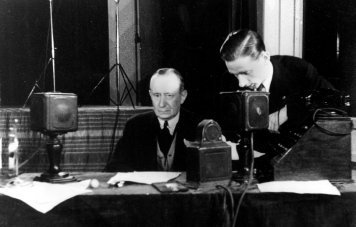Marconi had been commissioned by the Dublin Daily Express to report the progress of the Kingston Regatta (July 20–22nd July 1898). He did this from a steam tug, sending ‘wireless’ messages back to the harbour where they were subsequently telephoned to Dublin. Becoming what many believe to be have been the first ‘live’ transmission of a sporting event in the world, in the process he gained immense publicity for the technology and his Company.
via http://www.northantrim.com/Marconi.htm
and from http://url.ie/fsj1
In July 1898 the first public presentation of wireless telegraphy took place. Marconi had been commissioned by the Dublin Express to send telegraphic reports from the Kingston Regatta to its editorial offices. From on board the tug, Flying Huntress he observed the yachts racing in the Irish Sea and telegraphed his impressions directly to the land base in Kingston. The Dublin Express was able to keep its readers informed with extra pages on the current progress of the Regatta. With hindsight it is tempting to assign symbolic value to this episode in technological history. There are early indications here of what already appears to have been accomplished in our fast-paced media age: events being followed by the mass media in ‘real time’ with their highly sophisticated telecommunications equipment. What Marconi could only strive for in 1898 has been achieved in our time: the period between the occurrence of an incident and its announcement elsewhere has been shrunk to a minimum and is almost tending to zero.
and from http://irishmediaman.wordpress.com/1278-2/
“We understand that Marconi is coming to Dublin with his apparatus.” (Freemans Journal, 1898) Some months earlier at the Kingston Regatta the communicative possibilities of Marconi’s apparatus quickly came to light; “…he was watched with interest by many gentlemen who had been invited to witness the novel application of Marconi’s discovery to the uses of journalism.” (Kildare Observer, 1898)

